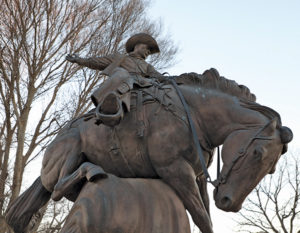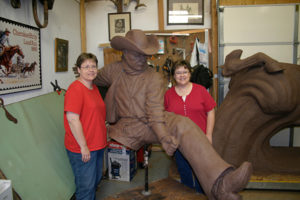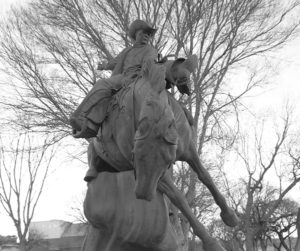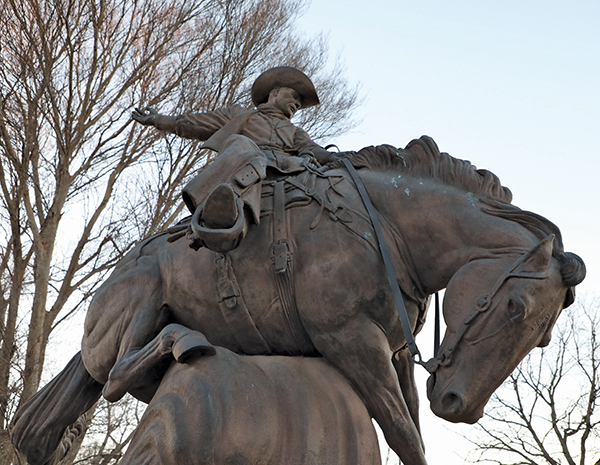By, LANEY COOK, Student Reporter

As people gathered on the north side of Northwestern’s Alva campus, a truck with a large flatbed could be seen coming down the road. On the back of the truck was the university’s iconic Ranger statue.
Since Nov. 13, 2007, the statue – which depicts a cowboy riding a horse – has stood at the corner of Oklahoma Boulevard and Highway 281.
It’s one of the first campus fixtures people see when they arrive at Northwestern. It represents the university’s mascot, the Ranger. But who is the cowboy atop the stallion supposed to look like?
The answer: No specific person.
As part of a new series of stories uncovering the history of monuments and statues at Northwestern, the Northwestern News recently spoke with the wife of Harold Holden, the Enid artist who created the statue.
Edna Mae Holden said her husband wasn’t trying to model a particular person when he drew plans for the cowboy atop the statue, a tall, mustachioed rider donning a western hat and leather chaps.
“It’s not anybody in particular,” Edna Mae Holden said. “He [Harold] was contacted about doing that monument for the university to kind of represent a Ranger.”
To design the statue, Harold Holden met with Tom and Brenda McDaniel, who donated the funds for it. Tom McDaniel was the university’s former president.
“They just kind of wanted him to do something emblematic of the way the Ranger would be depicted,” Edna Mae Holden said. “So, he did a little drawing. Then he did a little – what’s called a ‘pitch model,’ where he just does a little kind of replica out of clay real quickly to show them what he has in mind. And from there, they agreed on that, so he just proceeded to do that one.”
Skeeter Bird, the director of the Northwestern Foundation and Alumni Association, said the university bought three such statues as a package deal, with the ultimate goal being to put one on the university’s campuses in Alva, Enid and Woodward.
“At first, we thought that with Enid and Woodward being bigger, that they would be the first campuses that would get one,” Bird said. “But we had donors step up in both Alva and Enid.”
The Oklahoman newspaper reported at the time of the donation that the McDaniels donated the Alva statue as a gift to the university. On the Ranger Statue in Alva, people who helped fundraise and plan for the statue carved their initials into it.
Bird said that, before the statue was mounted, everyone on the fundraising committee was invited to Holden’s ranch north of Enid, where they were asked to carve their initials into the statue.
“At the time, I thought ‘Oh, this is no big deal,’” Bird said. “And then later, I’m like, ‘Hey, I can show my grandkids this one day.’”
Valarie Case, a Northwestern public relations specialist, said she was there on Nov. 13, 2007, to see the statue unloaded and mounted where it is now. It stands 10 feet high and sits on concrete base four feet wide.
“It was such an exciting thing to see the statue being driven up that day,” Case said. “And now we have this beautiful piece of art to represent our university.”

Three and a half months after the statue arrived in Alva, a Ranger statue was dedicated on the university’s Enid campus on Feb. 29, 2008. Harold Hamm, the chief executive officer of Continental Resources, Inc., and his wife, Sue, donated the statue as a gift to the university.
Cheryl Evans, the president of Northern Oklahoma College and the former president of Northwestern’s Enid campus, said there is a time capsule in the base of the Enid statue.
“We thought it would be fun to add some items that represented the university’s campus,” Evans said. “We ordered a capsule and added things like a class schedule, catalog, employee directory, newspaper clippings and stories about the Ranger.”
After they gathered everything up, they put it in the capsule and placed it inside the base, Evans said.
Bird said the third statue is at the university’s rodeo facility. It is not on display.
Before the statues were created, the Ranger mascot was the representation of the school, Bird said.
“This statue was part of our ‘Ride for Pride’ to kind of bring back the pride in the school,” Bird said. “It was a visible signature of that, and it has worked, I believe.”
— Editor-in-Chief Jordan Green contributed to this report.


